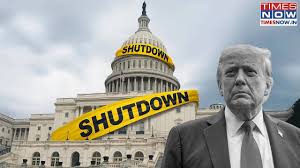Hey there — it’s been a dramatic week for markets, and as I sip my morning coffee on October 2, 2025, the headlines are dominated by a U.S. government shutdown. Funding lapsed at midnight on September 30, and despite frantic last-minute talks between President Trump and congressional leaders, we now face furloughs, closed agencies, and escalating political blame.
It’s the first shutdown since 2019, and though we’re only in the early stages, the ripple effects are already spreading far and wide. But the corner of the market that interests me most is crypto. Bitcoin is hovering around $117,000 after a modest dip, Ethereum remains jittery but steady, and stablecoins are soldiering on in relative silence.
In this article, we’ll unpack the shutdown, highlight major crypto developments (like Tim Cook’s Bitcoin admission), and explore how political chaos could turbocharge—or tank—your digital assets. Strap in; it won’t be boring.
What Sparked the Shutdown? The Politics Behind the Paralysis
To understand the fallout, we first need to understand how we got here.
On September 29, President Trump met with House Speaker Mike Johnson, Senate Majority Leader John Thune, and Democratic leadership to try and pass a continuing resolution that would keep federal funding alive past September 30. But the deal collapsed. Democrats pushed heavily to extend Affordable Care Act subsidies, warning that millions could lose coverage otherwise. Meanwhile, Republicans demanded a “clean” funding bill without extra spending or policy riders—and Trump himself floated new budget cuts.
In the Senate, the vote failed along party lines. The result: a government shutdown. Roughly 2 million federal workers who are deemed “nonessential” are now furloughed, agencies like the Bureau of Labor Statistics have paused operations, and programs such as the National Flood Insurance Program are stalled, freezing parts of the housing market.
Already, heated internal emails from the White House are blaming Democrats—and critics say some messaging skirts ethics laws. Meanwhile, prediction markets like Polymarket estimate over 60 % odds that this shutdown drags past mid-October.
(Al Jazeera)
For context, the last shutdown (2018–2019) lasted 35 days and centered on border wall funding. Then, markets trembled; this time, the core issues are health care, the debt ceiling, and mass layoffs. The human cost is real—veterans awaiting benefits, small businesses eyeing delayed loans—but for financial markets, uncertainty is the real weapon.
Tim Cook’s Crypto Reveal: What It Means (And Why It Matters)
Right amid this chaos, Apple CEO Tim Cook dropped a bombshell in a DealBook Summit interview: he confirmed he personally holds Bitcoin (and Ethereum). While he stressed this is a personal decision—not a corporate directive—his words landed with thunder in crypto circles.
Cook said he’s been accumulating BTC over the past three years as part of a balanced portfolio, quipping, “It’s reasonable to own some Bitcoin.” However, he clarified: don’t expect Apple to integrate digital assets into its treasury or product lines (no inbuilt wallet or crypto services yet).
(CryptoCompare)
Still, this is more than just news—it’s a signal. When high-profile leaders quietly endorse crypto, it chips away at skepticism in boardrooms. Bitcoin is now the ninth-largest asset class worldwide, and nods from tech giants only bolster its legitimacy.
(CoinDesk)
That said, Apple remains cautious. No NFTs. No wallet launches. But in a week where markets are jittery, Cook’s revelation might spark renewed institutional curiosity—or retail FOMO.
Why Stablecoins Are Quietly Taking Center Stage
If Bitcoin is the rockstar and Ethereum is the utility leader, stablecoins are the unsung sidekick holding everything together. And in times like these, they can shine.
Morgan Stanley parent Citigroup recently raised its long-term outlook for stablecoins to $1.9 trillion by 2030, with a bull scenario of $4 trillion—up from an earlier $1.6 trillion baseline. Much of that upgrade reflects a 40 % issuance surge year to date.
(Forbes)
Why are stablecoins attractive right now?
- Regulatory headwinds easing: Proposed rules (e.g. the GENIUS Act) aim to standardize issuance.
- Real utility: These pegged tokens settle over $18 trillion annually, outpacing traditional rails like Visa or Mastercard in sheer volume.
- Store of safety in a crisis: In environments with broken trust in fiat, stablecoins offer a digital refuge.
With reporting from agencies like the Bureau of Labor Statistics delayed, macro transparency fades. Enter USDT, USDC, and their peers—resilient alternatives functioning even when government systems pause. Institutional adoption is still nascent, but if bank-issued stablecoins enter the ring, they could reshape the volume landscape by decade’s end.
(Decrypt)
Cathie Wood’s Bold Stance: Bitcoin > Ethereum (Again)
No crypto conversation is complete without ARK Invest founder Cathie Wood’s perspective. In a September 28 podcast with Wilfred Frost, she reasserted her thesis: BTC will outperform ETH.
“Bitcoin owns the cryptocurrency space when it comes to pure crypto,” she argued, emphasizing its rules-based, global monetary system. While she acknowledges Ethereum’s role in DeFi and smart contracts, Wood warns that scaling pressures and competition from L2s erode ETH’s edge.
(Forbes)
ARK still maintains some exposure to Ethereum—through indirect bets like miner infrastructure—but its core conviction remains: Bitcoin is king. Their models project $710,000 as a base case by 2030, with upside towards $1.5 million in a bull run.
By contrast, some analysts talk up an ETH “supercycle” (targets of $10K–$15K). However, for Wood, Bitcoin’s purity and scarcity win in turbulent times.
(CoinDesk)
Especially during a shutdown, when faith in fiat gets shaken, Wood’s argument gains power: BTC’s store-of-value narrative is tailor-made for uncertainty.
Shutdown Risk = Policy Delays + Market Volatility
So how does this political mess hit crypto directly? The answer is: in multiple subtle but damaging ways.
Regulatory Bottlenecks
Key agencies like the SEC and CFTC are furloughing large parts of their staff. That means ETF approvals, crypto filings, and comment periods will slow or freeze entirely. For instance, the CLARITY Act, aimed at establishing market-wide crypto regulation, may be delayed indefinitely.
(Reuters)
SEC disclosure windows are being compressed, and new IPOs are already hitting roadblocks.
(Reuters)
Delays in crypto policy and oversight can exacerbate uncertainty—and crypto markets hate that.
(ForkLog)
Data Blackouts & Rate Ambiguity
In a shutdown, employment reports, inflation data, consumer spending numbers—all go on pause. Without consistent inputs, predicting Fed behavior becomes guesswork, and markets tend to overreact.
(ForkLog)
If rate cuts stall, liquidity tightens. If markets panic, capital flees. In short: crypto is vulnerable.
(Decrypt)
Mixed Historical Signals
Past shutdowns offer little clarity. In 2013, Bitcoin surged about 14% during a 16-day closure; in 2018, it plunged by 6% amid a prolonged shutdown.
(Decrypt)
Today’s backdrop is already bullish, and some analysts see room to run—especially if sentiment holds. However, downside risk looms if the shutdown drags or data surprises come back negative. Bitfinex, for example, flags $114K as a key support break.
(CoinDesk)
In altcoins, we may see sharper breakouts or deeper dips. The permutations are wide.
The Real-World Fallout (Beyond Markets)
Let’s zoom out: the shutdown isn’t just Wall Street drama—it’s real life.
- National parks, museums, and federal facilities have closed or scaled back operations.
- Consumer watchdogs like the FTC have suspended fraud and identity theft services.
(The Times of India) - Cybersecurity agencies, such as CISA, are critically understaffed, even as threats from ransomware and nation-states intensify.
(The Washington Post) - Credit market stress is rising. U.S. credit default swap spreads have ticked higher as default fears mount.
(Reuters) - GDP takes a hit: The White House warns of a $15 billion weekly loss in output if the shutdown continues.
(Politico) - IPO pipelines collapse: Deal momentum slows as regulatory approvals stall.
(Reuters)
For crypto-focused businesses, the shocks can be operational too: delayed grant funding, slowed KYC processing (if tied to federal oversight), or frozen approvals for new blockchain projects.
Yet in this upheaval lies opportunity. This just proves crypto’s brightest pitch: shutdown-proof, permissionless, always-on. Nigel Green of the deVere Group sees investors already hedging into Bitcoin and altcoins as fiat systems wobble.
What Comes Next? Strategy in the Fog
So, where do we go from here?
- Watch the duration. The average U.S. shutdown lasts eight days. If it resolves quickly, markets may shrug and rebound.
- Track the Fed. Their October meeting (October 29) could cement a rate path. If dovish, risk assets—including crypto—may catch wind.
- Monitor policy rollouts. When regulators return, ETF decisions, comment periods, and crypto frameworks could accelerate rapidly.
- Signal trades cautiously. Volatility is your friend—but it’s also your foe. For many, leaning into Bitcoin as a ballast makes sense; ETH and alts carry more event risk.
My leaning? Diversify, but tilt toward BTC as a core anchor. In a world where governments kink out, crypto’s decentralized design feels more essential than ever. As Wood put it: “Bitcoin is the monetary revolution we need.”
External links / references:
- CoinDesk: State of Crypto: Shutdown Watch (CoinDesk)
- ForkLog: What a U.S. Government Shutdown Means for Crypto (ForkLog)
- Reuters: U.S. Financial Regulators Start Shuttering (Reuters)
- Reuters: Government Shutdown Threatens IPO Market (Reuters)
- Politico: U.S. Could Lose $15B in GDP Each Week (Politico)
- Reuters
- Politico
- apnews.com
- The Washington Post
- The Times of India



























